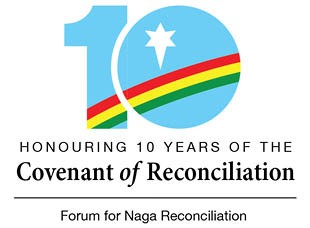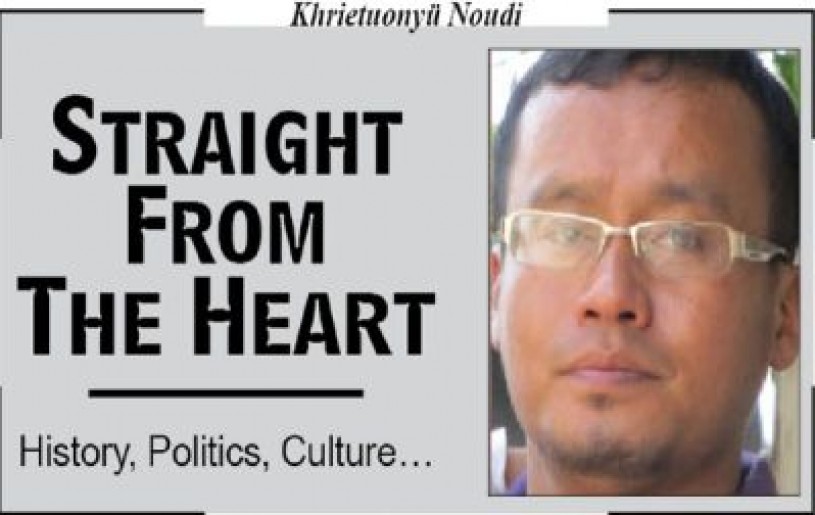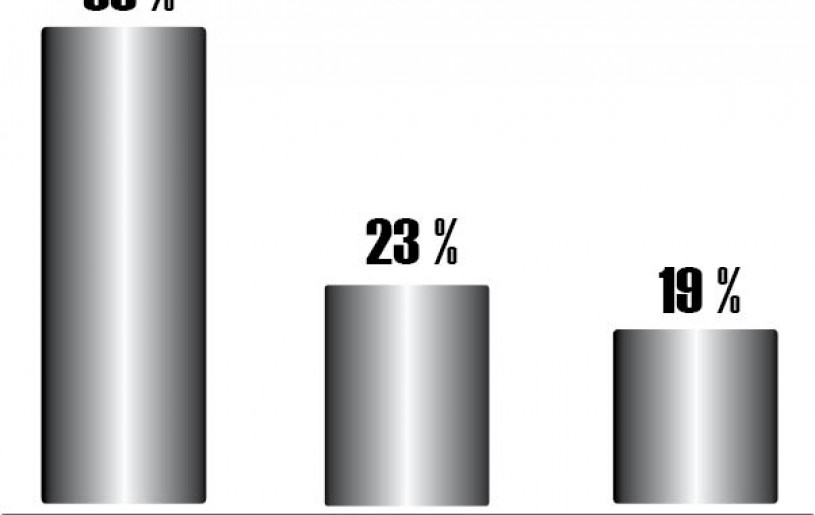
Nagaland speaks of its journey since the Covenant of Reconciliation (June 13, 2009)
Sometime in 1993-94, a gun battle ensued near my home in Dimapur. Though shielded by concrete houses, my fear stricken 10-year-old mind could only imagine bullets whizzing towards us; worse still, if it was an ambush, ‘combing operations’ would follow. A ceasefire came in 1997 but the fear remained. In the 2000s, this fear shifted to falling prey to machine gun fire by one of our own. Imagine, today, living without that basic, pressing, fear of being gunned down at any moment by anyone. - Imkong Walling, Journalist
Aheli Moitra*
Fear & Trauma
10 years have gone by since the Forum for Naga Reconciliation (FNR) brought three key leaders of the Naga movement, Isak Chishi Swu, SS Khaplang and S Singnya, to sign the Covenant of Reconciliation (CoR) on June 13, 2009. The leaders committed themselves to “Naga Reconciliation and forgiveness based on the historical and political rights of the Nagas.” The Covenant was a milestone in the world that the Naga people came to inhabit after the ceasefires of 1997 (GoI-NSCN IM) and 2001 (GoI-NSCN K).
“In the 3-4 years leading to the signing of the CoR, violence had peaked,” remembers journalist Merina Chishi as we speak over coffee at a bakery in Dimapur. 10 years ago, the peace of mind required to carry on such reflections in a public space would have been a luxury. Today, we are not plagued by the kind of fear or suspicion that swamped those post ceasefire years.
“Cadres were deserting one camp (group) for the other; if they bumped into each other on the streets, they shot,” explains Chishi.
The theatre of the ‘deserters’ war, as she terms it, had moved into Nagaland’s cities. Gun battles became a hallmark of the urbanscape, “mainly in Dimapur,” notes journalist Imti Longchar. “If the Naga groups fought each other in the remote hills in the late 1980s, in the 2000s, they were fighting it out in urban civilian areas.”
Journalists were over-stretched. 2005 onwards, many nights would bring news of gunfights and an unidentified corpse, “particularly along the National Highway 29,” says Longchar. Journalists responded even before the Nagaland police whose major role during the years was to “retrieve bodies,” wrote The Telegraph.
Throughout 2007 and 2008, ‘interfactional’ violence took ‘inter-community/tribal’ colour and vice versa—among the Nagas, colonies were burned down, camps raided, brothers waylaid and scores killed.
The fear, suspicion, cynicism and desensitization to violence among people had gone beyond nausea.
“In early 2009, I had seen a gruesome dead body to report on the matter,” narrates former journalist Bonnie Konyak. “Soon after, we were at the East Police Station for further reports and I was so hungry I gorged down a plate of puri-sabji. Someone asked me, how can you eat after seeing all that? That’s when I realized how desensitized I had become to the violence, too comfortable with death,” reveals Konyak, voicing many civilians of the time.
They were “stressed out, overworked and traumatized.” It resulted in her leaving the field to become a health worker in her home district, Mon, where she has lived ever since.
The State remained a spectator and “the onus of peace fell upon the public,” says Imti Longchar. As gunfights continued, women of the colonies, he reminisces, often “came out in groups beating dekchis (steel pots and pans) with sticks and stones to ask the groups to vacate the area.”
But these ad-hoc efforts could not be sustained. The Naga civil society eventually came together to affect the formation of the FNR in 2008. Several meetings and activities later, the CoR between the three leaders came into being in 2009.
“Slowly, but steadily, the killings stopped,” acknowledges Merina Chishi.
In Pursuit of Peace
Nagaland has seen a spurt of growth and development in the last 10 years. Real estate has proliferated in urban areas, schools of higher education have emerged, new civil rights’ movements have taken shape, government schemes have penetrated remote areas and entrepreneurship has become a trend. Indigenous women farmers can reach city markets at a greater pace today, 545 Non Government Organizations are registered in Nagaland State annually, mobile phone networks are accessible throughout the hills.
For Bonnie Konyak, the CoR was a “milestone” that carved a path for these events to unfold. “The CoR provided the groups with the first opportunity to sit together and arrive at a common understanding. It was commendable on part of the FNR to open the door to all groups; a good beginning,” propounds Geoffrey Yaden, Editor of Nagaland Post.
The ceasefire between the Government of India and the NSCN (IM) in 1997, and the then NSCN (K) in 2001, had provided little scope for the same. “The ceasefires were not well defined and there was no written document to adhere to,” informs Alemtemshi Jamir (IAS retd.), who was the Development and Planning Commissioner of Nagaland State in the early 2000s. While it left State agencies helpless, the FNR’s efforts bore fruit. “It led to the reduction of violence and removed the heavy air of tension.”
For Fr. Dr. CP Anto, Principal of the North East Institute of Social Sciences and Research, Dimapur, “Reconciliation is an abstract, philosophical concept. The signing of the CoR in 2009 converted it into a reality for the Nagas.”
The CoR was a “political, social and moral commitment by the leaders of the groups responding to the desire of every individual, home, family, church, civil society and intellectual for peace,” maintains Toshi Wungtung, advisor to the Eastern Nagaland Peoples’ Organization (ENPO) in the early years of the FNR, as well as the ENPO’s representative to the Naga Reconciliation Process. Currently, he is advisor to the Government of Nagaland for Information & Public Relations, SCERT and Village Guards.
“It generated a lot of hope among Naga people. The football matches that followed between national workers and Naga civil society showed to the people that they could work together despite being from different groups,” he elucidates. For the groups, the activities facilitated by the FNR helped them “express themselves freely, bringing them closer together, removing animosity and hatred.”
A renewed hope sprouted – that the signatory groups will come together, present a common Naga front at the Indo-Naga talks table to pursue a common agenda.
“What the ceasefires could not achieve, the Naga Reconciliation Process did. It gave out the strong message that no group had monopoly of the Naga issue and that all Nagas are stakeholders in the peace process,” Wungtung asserts.
“It also brought home the message that unless you stopped killing each other, you cannot pursue a common solution,” he notes, while giving a background on how the ENPO had already resolved alongside Eastern Naga national workers across groups – on December 18, 2007 – that no in-fighting will be entertained in the “ENPO areas” consisted of Mon, Tuensang, Noklak, Kiphire and Longleng districts. The same had to be extended to all Naga areas, beyond borders, for which the FNR-led process became necessary.
The non-Naga communities of West Indian origin living in Nagaland also felt its impact. Throughout the 1990s and 2000s, almost every non-Naga business family had at least a relative or two kidnapped by Naga political groups. “If you made Rs. 50,000, someone in your family was likely to be kidnapped for 10 days at a stretch,” reveals a prominent businessperson, whose family has been based in Dimapur since 1880. If kidnapped, the families had to pay up; they could neither approach the police nor the army.
The Naga Reconciliation Process, or even the CoR, facilitated by the FNR may be conceptually blurred in their memories, but they acknowledge the last 10 years have brought respite.
“Earlier, if you had asked us about Naga political groups, we wouldn’t even be willing to talk about it,” shrugs a social worker from the non-Naga community as we meet in a confined undisclosed location. Free speech seems to be a luxury for them even today. Most of the old inhabitants of Dimapur have shared close relationships with the Naga national workers of yore – “when they came down to Dimapur in the early years of the struggle, they would stay with us. Their fight was with the Government of India, not us. Both our communities recognized that.”
While such an integrated understanding of the shared space is yet to emerge, “the horror of the 1990s and 2000s has diminished,” they admit. “There are no more kidnappings. Now the groups operate taxation smoothly and even the pen you are writing with has been syndicated,” adds the businessperson.
‘Black Became White’
Development, notes Geoffrey Yaden, is not just “buildings coming up” nor is the economy “run through entrepreneurship.” Yaden is responding to questions raised on how the economy has benefitted in the years post signing of the CoR—as killings reduced, has the economy gained?
“Extortion curbs economic activities,” he says, and “post 2003, the government has become free for all.” He uses a slightly different peg – Dimapur was a flowering economy till the Naga political groups recognized its importance as the “land of milk and honey” in the late 1980s; as the number of ‘factions’ proliferated over the past decade, Nagaland’s economy took a toll. Infrastructure collapsed, in his opinion, as did business and industry.
2003 onwards, civil society organizations seemingly “worked closely” with the government in Nagaland State and Naga political groups dug their heels deeper into state politics. “In a way, the FNR spoiled the party but was unable to sustain this action,” notes another journalist.
Ultimately, the question emerged, did reconciliation really happen? If not, then what happened?
Merina Chishi highlights, “10 years back, you wouldn’t see a bureaucrat play badminton or have tea with a national worker in public. It is common now. Fear used to be a shield between us and them, now it is gone.”
Isn’t that a good thing?
“Yes. Reconciliation has helped the Naga national workers and the civil society – they got contracts and expanded their businesses,” she concedes. This was already happening post 2003, she reflects, but post 2009, “much of what was black became white.”
Chishi adds the more difficult, “grey areas,” to her analysis. National workers who run businesses, for instance, have to inadvertently pay taxes to the Government of India; their children have to study in schools that begin each day with the Indian national anthem; like all Indian citizens, they need Aadhaar cards and voter identity cards.
Disparate threads twine through one another, lending unintended colour and design to the Naga fabric.
“The State Government’s role became larger in the lives of the Nagas and civil society was co-opted by the State in the last 15 years,” proposes an observer from Eastern Nagaland who wished to remain anonymous. The implication is of the osmosis that gripped the ‘overground’ and ‘underground’ governments.
“Taxation became unabated. Bureaucrats were happy to blame national workers for corruption. In turn, national workers made friends with bureaucrats and demanded disproportionate benefits. Politicians and national workers cooperated to win elections. It became a nexus of immorality that engulfed us all.”
In a public statement in September 2017, the FNR acknowledged as much, and went a step further. “There is alarming increase of social ills and the nexus between Naga National Groups and vested individuals and parties are strengthening the culture of impunity.”
In such a space, Naga civil society fractured. Several movements against corruption and for civil rights emerged in Nagaland State, but few sustained. “Peoples’ movements cannot survive in a space of negative peace,” reminds Fr. Anto.
While the effects of this began to widen the gulf of wealth in Naga society, “the poor remained choiceless,” feels Merina Chishi. “What option does a poor widow who lives hand-to-mouth have? For the educated and elite, reconciliation is a liberating concept but that widow has to silently move on with her struggles intact.”
Hopes for the Future
Was the Naga Reconciliation Process that unfurled after the signing of the CoR conceptually heavy? Did it fall prey to misconceptions in the minds of the public? Could the Process have been designed otherwise?
While acknowledging that the resultant situation was beyond the FNR’s control, 90% of the commentators on this subject chose ‘yes’ to all of the above.
One of the biggest challenges towards taking the Process forward remained the idea in the peoples’ minds and imagination that the FNR “sided with” one of the Naga political groups. On the other hand, this very political group was miffed that FNR had “equalized” all groups irrespective of their expertise in terms of political acumen, networks, firepower or discipline.
For the public, this “equalization” and the “neutral” open-to-all approach of the FNR was what gained the people’s trust. But, at the time, the “solution-centric political language” also made it seem like FNR publicly supported the group, the only one to be in talks with the Government of India then.
The quagmire this led the FNR to may have had an unpleasant effect, but fortunately not all was lost. “The NNPGs coming together for the peace talks in this manner would not have been possible today if not for the FNR’s work in the yesteryears,” affirms Alemtemshi Jamir.
The scope of FNR’s work also remains large. Reconciliation in the Naga context, felt some commentators, is not just about groups coming together. The issues that led to the groups ‘factionalizing’ were political, social, cultural and economic.
“Ingrained in the factional violence was the feeling of superiority of one community/tribe over the other. Discrimination and prejudice among communities/tribes led to unfair treatment and bred contempt leading to factionalism. This was a serious issue for the Eastern Nagas. If there was a third force operating at all, we allowed the third force to exploit us,” maintains the observer from Eastern Nagaland.
Non-Naga communities feel the pinch of this “prejudice” in daily life. They provide a reflection perhaps useful for the Naga Reconciliation Process—“we are ready to reconcile if we are recognized as equals,” says the non-Naga social worker. “If you just make a place in your hearts for us, we can give back a lot more,” offers the non-Naga businessperson.
To do this, both Toshi Wungtung and Geoffrey Yaden – in separate interviews – say that “Naga politics is in need of reformation and transformation.” Both prefer that the church be central to the process.
“If we allow ourselves to be unjust to others today, we will easily do it to our own tomorrow,” cites Yaden, calling for democratizing the social space for all to “develop and grow.”
These comments point to hopes for the future, and the extent to which “forgiveness and healing” is required in the society if “true reconciliation” is to take shape.
In Fr. Anto’s opinion, “After washing each others’ feet and playing football, there needed to be celebration, then dialogue towards change of perspective and attitude, ultimately leading to a solution to the problem faced. But we didn’t see the process of forgiveness leading to healing and then reconciliation.”
A scholar of conflict transformation, Fr. Anto suggests, “A dialogue forum for reconciliation should be established at the State, District and Sub-division levels across the Naga areas. Reconciliation should be taught in schools, preached in churches and witnessed in person. Newspapers should constantly carry the message of reconciliation. For the next 10 years, this message should percolate to the grassroots and Naga society should support the individuals and their families that take up this task full time.”
These suggestions are rooted in a new line of thought—that Reconciliation be the principle and mandate based on which Nagas Beyond Borders rediscover their peoplehood, self-fulfilling the aspiration for nationhood.
About the author:
*Aheli Moitra is a journalist based in Dimapur, Nagaland.
This is the eighth article of a 13-part series by the Forum for Naga Reconciliation on the 10th year of signing of the Covenant of Reconciliation (CoR) by Isak Chishi Swu, Chairman, NSCN/GPRN; SS Khaplang, Chairman, GPRN/NSCN and Brig (Retd) S Singnya, Kedahge (President), FGN on June 13, 2009. To celebrate the milestone, a cross section of authors will assess and highlight the impact of the CoR as well as examined, critiqued and encouraged the process in the series.





